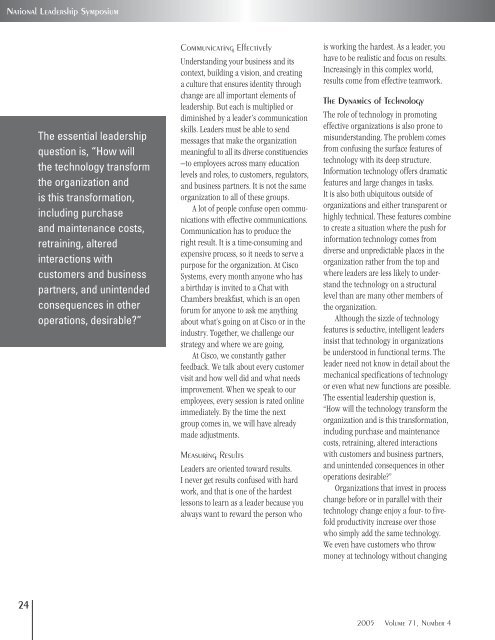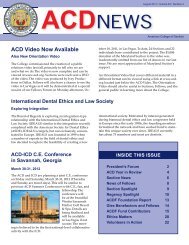JACD 71-4 - American College of Dentists
JACD 71-4 - American College of Dentists
JACD 71-4 - American College of Dentists
- No tags were found...
Create successful ePaper yourself
Turn your PDF publications into a flip-book with our unique Google optimized e-Paper software.
National Leadership Symposium<br />
24<br />
The essential leadership<br />
question is, “How will<br />
the technology transform<br />
the organization and<br />
is this transformation,<br />
including purchase<br />
and maintenance costs,<br />
retraining, altered<br />
interactions with<br />
customers and business<br />
partners, and unintended<br />
consequences in other<br />
operations, desirable?”<br />
Communicating Effectively<br />
Understanding your business and its<br />
context, building a vision, and creating<br />
a culture that ensures identity through<br />
change are all important elements <strong>of</strong><br />
leadership. But each is multiplied or<br />
diminished by a leader’s communication<br />
skills. Leaders must be able to send<br />
messages that make the organization<br />
meaningful to all its diverse constituencies<br />
—to employees across many education<br />
levels and roles, to customers, regulators,<br />
and business partners. It is not the same<br />
organization to all <strong>of</strong> these groups.<br />
A lot <strong>of</strong> people confuse open communications<br />
with effective communications.<br />
Communication has to produce the<br />
right result. It is a time-consuming and<br />
expensive process, so it needs to serve a<br />
purpose for the organization. At Cisco<br />
Systems, every month anyone who has<br />
a birthday is invited to a Chat with<br />
Chambers breakfast, which is an open<br />
forum for anyone to ask me anything<br />
about what’s going on at Cisco or in the<br />
industry. Together, we challenge our<br />
strategy and where we are going.<br />
At Cisco, we constantly gather<br />
feedback. We talk about every customer<br />
visit and how well did and what needs<br />
improvement. When we speak to our<br />
employees, every session is rated online<br />
immediately. By the time the next<br />
group comes in, we will have already<br />
made adjustments.<br />
Measuring Results<br />
Leaders are oriented toward results.<br />
I never get results confused with hard<br />
work, and that is one <strong>of</strong> the hardest<br />
lessons to learn as a leader because you<br />
always want to reward the person who<br />
is working the hardest. As a leader, you<br />
have to be realistic and focus on results.<br />
Increasingly in this complex world,<br />
results come from effective teamwork.<br />
The Dynamics <strong>of</strong> Technology<br />
The role <strong>of</strong> technology in promoting<br />
effective organizations is also prone to<br />
misunderstanding. The problem comes<br />
from confusing the surface features <strong>of</strong><br />
technology with its deep structure.<br />
Information technology <strong>of</strong>fers dramatic<br />
features and large changes in tasks.<br />
It is also both ubiquitous outside <strong>of</strong><br />
organizations and either transparent or<br />
highly technical. These features combine<br />
to create a situation where the push for<br />
information technology comes from<br />
diverse and unpredictable places in the<br />
organization rather from the top and<br />
where leaders are less likely to understand<br />
the technology on a structural<br />
level than are many other members <strong>of</strong><br />
the organization.<br />
Although the sizzle <strong>of</strong> technology<br />
features is seductive, intelligent leaders<br />
insist that technology in organizations<br />
be understood in functional terms. The<br />
leader need not know in detail about the<br />
mechanical specifications <strong>of</strong> technology<br />
or even what new functions are possible.<br />
The essential leadership question is,<br />
“How will the technology transform the<br />
organization and is this transformation,<br />
including purchase and maintenance<br />
costs, retraining, altered interactions<br />
with customers and business partners,<br />
and unintended consequences in other<br />
operations desirable?”<br />
Organizations that invest in process<br />
change before or in parallel with their<br />
technology change enjoy a four- to fivefold<br />
productivity increase over those<br />
who simply add the same technology.<br />
We even have customers who throw<br />
money at technology without changing<br />
2005 Volume <strong>71</strong>, Number 4





